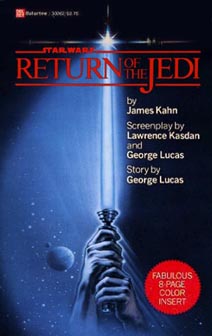The original trilogy wraps up in book form with James Kahn’s “Return of the Jedi” novelization (1983), which – mostly for better, sometimes for worse – is a blend of the styles of Alan Dean Foster and Donald F. Glut. It has some of the pulpy poetry of the former, but like the latter, it’s written in a third-person omniscient style with lots of capitalized character and species names that none of our heroes would be privy to, from “Weequay” to “Ewok.”
Skywalker family backstory
Still, up until the release of “Revenge of the Sith” in 2005, Kahn’s book – which, of course, draws from the not-quite-final “Jedi” script by George Lucas and Lawrence Kasdan — was the best source for the backstory of the Skywalker family. This is how we knew, 22 years before we saw it on screen, that Anakin “fell into a molten pit” and emerged as Darth Vader (page 64 of the hardcover).
While that tidbit is accurate, the “Jedi” novelization stands as irrefutable evidence that Lucas was still working out the specifics of Episodes I-III when he wrapped up the original trilogy. Indeed, if we accept Obi-Wan’s “certain point of view” excuse for his fib about the identity of Luke’s father — the film itself holds the most blatant continuity mistake in the saga: Leia’s assertion that she has memories of her mother.

“Return of the Jedi” novelization (1983)
Author: James Kahn
While this could possibly be explained as Force-influenced false memories – or possibly tales that Bail and Breha recounted to their adopted daughter — the “Jedi” novelization makes it clear that, in 1983, Lucas had Padme (unnamed in this book) surviving childbirth. From page 119:
Flashes from (Leia’s) infancy assaulted her. Distorted visions of running … a beautiful woman … hiding in a trunk.
Obi-Wan’s extended speech to Luke provides more examples of how Lucas was still shaping the backstory. On page 66, Ben delivers three falsehoods that are obviously there because Lucas later altered the story, not because the Jedi Master is doing his “certain point of view” thing. First, Obi-Wan says Anakin didn’t know Padme was pregnant, then he says Owen is his brother, then he says Padme took Leia to live with Senator Organa.
Another small misfire occurs on page 178, during a rather nice segment where a dying Anakin reflects on his life: “He wished, briefly, he’d met Yoda, to thank the old Jedi for the training he’d given Luke.” I suppose we can read this as “He wished he’d met Yoda again, within the past two decades,” and make it work.
Luckily, people don’t get locked into novelizations the way they do to films, so Lucas didn’t face much backlash for changing his mind about these details. I think he missed an opportunity to make Owen and Obi-Wan brothers in “Episode II”; it would’ve deepened Obi-Wan’s backstory while also adding depth to the rift between Lars and Kenobi at the start of “A New Hope.”

On the other hand, Padme dying in childbirth at the same time Anakin is reborn as Vader — and, indeed, Palpatine manipulating the Living Force to kill her — has more poetry to it than the way the “Jedi” novel tells it, where Padme merely dies when Leia is very young, by an unknown cause.
Palpatine the manipulator
In fairness, it should be noted that Lucas (and therefore Kahn) hit it pretty close to the mark on other things. While Kahn somewhat follows Foster’s lead of noting that corruption within the Republic existed outside of Palpatine’s machinations, he also makes it clear (unlike Foster) that Palpatine was not a passive opportunist. On page 69, he writes:
Through fraud, clever promises, and astute political maneuvering, he’d managed to get himself elected head of the Council. And then through subterfuge, bribery and terror, he’d named himself Emperor.
Kahn also accurately recounts Mon Mothma’s backstory on page 72:
Mon Mothma had been a senior senator of the Republic. … When the Republic had begun to crumble, Mon Mothma had remained a senator until the end, organizing dissent, stabilizing the increasingly ineffectual government. She had organized cells, too, toward the end. Pockets of resistance, each of which was unaware of the identity of the others – each of which was responsible for inciting revolt against the Empire when it finally made itself manifest.
Luke dabbles with dark side
Its status as a repository of rough-draft prequel ideas remains the coolest part of Kahn’s book, but the author also punches up the film’s narrative within the internal continuity. The movie certainly includes elements of Luke flirting with the Dark Side: Most notably, he attempts to strike down the Emperor in anger and later cuts Vader’s hand off in anger. Less hyped up is the fact that he briefly uses the Force to choke a Gamorrean Guard.
But Kahn more explicitly plays up Luke’s dabbling with the dark side. On page 37, after telling Jabba that not bargaining is the last mistake he’ll ever make:
Luke was unable to suppress the satisfaction in his voice. He found Jabba despicable – a leech of the galaxy, sucking life from whatever he touched. Luke wanted to burn the villain, and so was actually rather glad Jabba had refused the bargain – for now Luke would get his wish precisely. … To free the universe of this gangster slug – this was a prospect that tinted Luke’s purpose with an ever-so-slightly dark satisfaction.
In fact, Yoda had sensed Luke’s feelings through the Force (page 61): “When you rescued your friends, you had revenge in your heart.”
The author’s prose during the Emperor’s throne-room sequence further emphasizes Luke’s internal conflict. On page 134, Luke acknowledges to himself that turning to the dark side is an option on the table:
A black storm raged inside him. … Luke had a brief murky image of himself, standing on his father’s body, holding his father’s blazing power, and sitting at the Emperor’s right hand. He squeezed his eyes shut against this thought, but it left a cold sweat on his brow, as if Death’s hand had brushed him there and left its shallow imprint.
Thankful Han
Han Solo’s arc is also ratcheted up considerably by the “Jedi” novelization, as the smuggler voices his feelings more openly. On page 53, as a capper to the sandstorm scene that was cut from the film, Han thanks his friends for saving his life and then reflects on their actions:
(They) put their own lives in great peril at his expense, for no other reason than that … he was their friend. This was a new idea for the cocky Solo – at once terrible and wonderful.
This plays quite differently compared to the film, where Han’s thank-you comes over the comlink to Luke’s X-Wing. It’s still heartfelt, but more of a throwaway line.
Han’s inner journey continues on page 113, when he gives a monologue to sway the Ewoks to the Rebels’ side:
“Mostly I do things for my friends now – ’cause what else is so important? Money? Power? … The point is – your friends are … your friends. You know?”
Not of this Earth … or is it?
Going beyond characterization, Kahn clarifies a logistical point. In the film, thanks to editing that’s exciting but nonsensical, it seems like Luke and Leia swing from a rope attached to nothing. The author explains it nicely on page 51: “Luke … grabbed ahold of a rope from the rigging of the half blown-down mast.”
In terms of wording choices, Kahn’s book is an unfortunate step back toward Foster’s favoring of Earth terms. Even at a time when “Star Wars” had become part of the zeitgeist, Kahn for some reason thinks readers need Earth as a point of reference. “The two space armadas, like their sea-bound counterparts of another time and galaxy …” he writes on page 167.
He regularly describes Ewoks as “teddy bears” (first on page 94), and at other points references puppies (95), monkeys (106), crickets and owls (118), scorpions (142), dragonflies (143) and cobras (128); I’ll give him a pass on the latter point since Lando’s ship in the Marvel comics is the Cobra.
On the other hand, he calls Luke’s shirt a “tunic” on page 32, so this is an early use of a word that would become a staple of the Expanded Universe novels, which really started to establish a specific collection of “Star Wars” words with “Heir to the Empire” in 1991. (Unfortunately, the Disney canon has dropped this wonderful affectation.)
More tidbits
Here’s a look at some other points and whether Kahn got them “right” or “wrong” compared to what was later established in the EU:
- Endor is “a moon whose mother planet had long since died of unknown cataclysm and disappeared into unknown realms” (page 1). Nope, this is just a hoax, according to the EU’s retconners: The planet Endor still exists.
- Jabba’s palace has “massive iron doors, taller than Threepio could see” (8). The door isn’t so big in the original version of the film, but Lucas made it match Kahn’s description (and his original vision) better in the 2011 Blu-ray.
- Kahn presents Ishi Tib (24) and Barada (38) as names of individuals, but they were later established as species names. His writing about Weequays (38) was more or less carried over to “Tales from Jabba’s Palace,” though: “No one was certain whether Weequay was the name of their tribe, or their species; or whether all in their tribe were brothers, or all were named Weequays. It was known only that these two were called by this name.”
- Jabba hates Ephant Mon (40): “Jabba chuckled to see Ephant Mon go down.” This jibes with “Tales from Jabba’s Palace,” where the two are initially allies, but Ephant Mon eventually breaks free of his debt to the crime lord.
- The Battle of Taanab is explained (73): “Taanab was agrarian planet raided seasonally by bandits from Norulac. Calrissian – before his stint as governor of Cloud City – had wiped out the bandits against all odds, using legendary flying and unheard of strategies. And he’d done it on a bet.” The specifics of this battle were later explored in “The Essential Guide to Warfare,” but I rather like the idea from “Tag and Bink Are Dead 2” that Tag actually won the Battle of Taanab but Lando took credit for it in order to pick up women.
‘Bonus scenes’
How about “bonus scenes?” The most notable examples are an extended assault on the bunker and Palpatine’s and Jerjerrod’s goal of turning the Death Star’s superlaser on Endor should the shield fall (the 2011 Blu-ray includes all of these unfinished cut scenes).
As with “A New Hope,” the space station explodes before it can fire on the moon. This brazen redundancy was a good reason to excise this sequence, although it does allow for more insight into Jerjerrod, who surprisingly is a galactic bully rather than the timid man we see on screen.
Indeed, it is Kahn’s willingness to delve into characters – more so than Foster and Glut did – that gives his book more talking points than his two predecessors (I’d still rank Foster’s effort first among the trilogy, though, as he’s a better wordsmith).
Even with all the slightly off-point references to the prequels, the “Return of the Jedi” novelization at least has an emotional ring of truth as a portrait of the Skywalker family as it is redeemed. As such, it works as both a historical curiosity and a pretty solid read in its own right.

